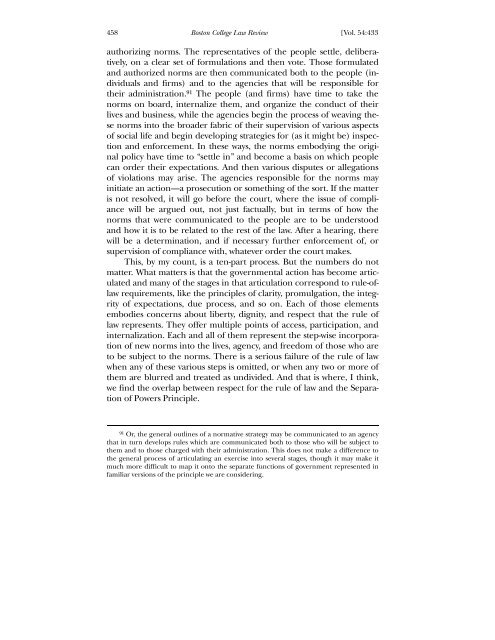separation of powers in thought and practice? - Boston College
separation of powers in thought and practice? - Boston College
separation of powers in thought and practice? - Boston College
You also want an ePaper? Increase the reach of your titles
YUMPU automatically turns print PDFs into web optimized ePapers that Google loves.
458 <strong>Boston</strong> <strong>College</strong> Law Review [Vol. 54:433<br />
authoriz<strong>in</strong>g norms. The representatives <strong>of</strong> the people settle, deliberatively,<br />
on a clear set <strong>of</strong> formulations <strong>and</strong> then vote. Those formulated<br />
<strong>and</strong> authorized norms are then communicated both to the people (<strong>in</strong>dividuals<br />
<strong>and</strong> firms) <strong>and</strong> to the agencies that will be responsible for<br />
their adm<strong>in</strong>istration.91 The people (<strong>and</strong> firms) have time to take the<br />
norms on board, <strong>in</strong>ternalize them, <strong>and</strong> organize the conduct <strong>of</strong> their<br />
lives <strong>and</strong> bus<strong>in</strong>ess, while the agencies beg<strong>in</strong> the process <strong>of</strong> weav<strong>in</strong>g these<br />
norms <strong>in</strong>to the broader fabric <strong>of</strong> their supervision <strong>of</strong> various aspects<br />
<strong>of</strong> social life <strong>and</strong> beg<strong>in</strong> develop<strong>in</strong>g strategies for (as it might be) <strong>in</strong>spection<br />
<strong>and</strong> enforcement. In these ways, the norms embody<strong>in</strong>g the orig<strong>in</strong>al<br />
policy have time to “settle <strong>in</strong>” <strong>and</strong> become a basis on which people<br />
can order their expectations. And then various disputes or allegations<br />
<strong>of</strong> violations may arise. The agencies responsible for the norms may<br />
<strong>in</strong>itiate an action—a prosecution or someth<strong>in</strong>g <strong>of</strong> the sort. If the matter<br />
is not resolved, it will go before the court, where the issue <strong>of</strong> compliance<br />
will be argued out, not just factually, but <strong>in</strong> terms <strong>of</strong> how the<br />
norms that were communicated to the people are to be understood<br />
<strong>and</strong> how it is to be related to the rest <strong>of</strong> the law. After a hear<strong>in</strong>g, there<br />
will be a determ<strong>in</strong>ation, <strong>and</strong> if necessary further enforcement <strong>of</strong>, or<br />
supervision <strong>of</strong> compliance with, whatever order the court makes.<br />
This, by my count, is a ten-part process. But the numbers do not<br />
matter. What matters is that the governmental action has become articulated<br />
<strong>and</strong> many <strong>of</strong> the stages <strong>in</strong> that articulation correspond to rule-<strong>of</strong>law<br />
requirements, like the pr<strong>in</strong>ciples <strong>of</strong> clarity, promulgation, the <strong>in</strong>tegrity<br />
<strong>of</strong> expectations, due process, <strong>and</strong> so on. Each <strong>of</strong> those elements<br />
embodies concerns about liberty, dignity, <strong>and</strong> respect that the rule <strong>of</strong><br />
law represents. They <strong>of</strong>fer multiple po<strong>in</strong>ts <strong>of</strong> access, participation, <strong>and</strong><br />
<strong>in</strong>ternalization. Each <strong>and</strong> all <strong>of</strong> them represent the step-wise <strong>in</strong>corporation<br />
<strong>of</strong> new norms <strong>in</strong>to the lives, agency, <strong>and</strong> freedom <strong>of</strong> those who are<br />
to be subject to the norms. There is a serious failure <strong>of</strong> the rule <strong>of</strong> law<br />
when any <strong>of</strong> these various steps is omitted, or when any two or more <strong>of</strong><br />
them are blurred <strong>and</strong> treated as undivided. And that is where, I th<strong>in</strong>k,<br />
we f<strong>in</strong>d the overlap between respect for the rule <strong>of</strong> law <strong>and</strong> the Separation<br />
<strong>of</strong> Powers Pr<strong>in</strong>ciple.<br />
91 Or, the general outl<strong>in</strong>es <strong>of</strong> a normative strategy may be communicated to an agency<br />
that <strong>in</strong> turn develops rules which are communicated both to those who will be subject to<br />
them <strong>and</strong> to those charged with their adm<strong>in</strong>istration. This does not make a difference to<br />
the general process <strong>of</strong> articulat<strong>in</strong>g an exercise <strong>in</strong>to several stages, though it may make it<br />
much more difficult to map it onto the separate functions <strong>of</strong> government represented <strong>in</strong><br />
familiar versions <strong>of</strong> the pr<strong>in</strong>ciple we are consider<strong>in</strong>g.
















